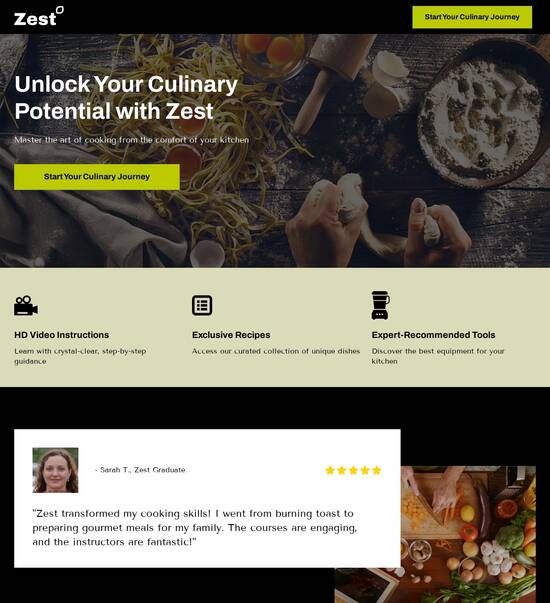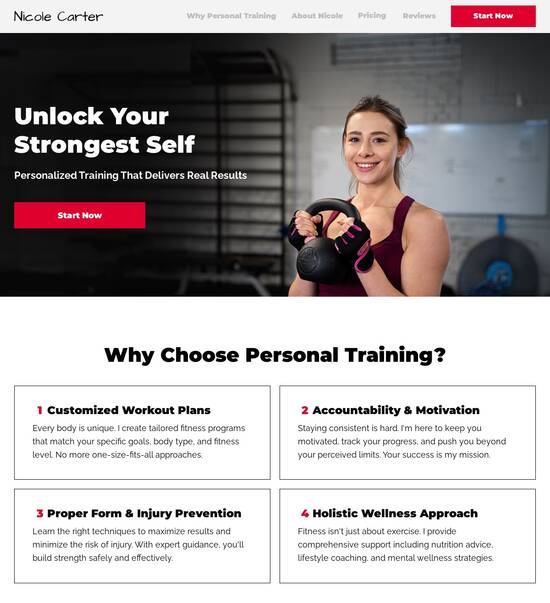
Dynamic 404 error page template
Explore Similar TemplatesAbout template
Unleash your creativity with the dynamic 404 error page template. Try Instapage today.
Recommended templates

Easy to build without coding
With the intuitive drag-and-drop builder, anyone on your team can create high-converting pages without any knowledge of code or design. Make enhancements to your landing page with custom widgets using Javascript, HTML/CSS, or third-party scripts.

Multiple layouts for any industry and goal
Select from 500+ landing page layouts built to boost conversions across industry-specific scenarios. Customize them by adjusting fonts, adding images, and generating on-brand content with the AI assistant. Quickly scale with Instablocks® and Global Blocks that you can save, reuse, and update globally.

Loads fast and looks polished on any device
Every template is responsive, which means they present professionally on any device and load blazingly fast with our Thor Render Engine. You can also power them up with Google AMP technology to deliver an unparalleled mobile experience and drive higher conversions.

Robust analytics & experimentation
Get real-time updates and reporting across all your devices, showing the number of visitors, conversions, cost-per-visitor, and cost-per-lead. Launch AI-powered experiments, run A/B tests, and use heatmaps to analyze user behavior, then optimize your landing page to maximize conversions.







Easy to build without coding
With the intuitive drag-and-drop builder, anyone on your team can create high-converting pages without any knowledge of code or design. Make enhancements to your landing page with custom widgets using Javascript, HTML/CSS, or third-party scripts.
Multiple layouts for any industry and goal
Select from 500+ landing page layouts built to boost conversions across industry-specific scenarios. Customize them by adjusting fonts, adding images, and generating on-brand content with the AI assistant. Quickly scale with Instablocks® and Global Blocks that you can save, reuse, and update globally.
Loads fast and looks polished on any device
Every template is responsive, which means they present professionally on any device and load blazingly fast with our Thor Render Engine.
Robust analytics & experimentation
Get real-time updates and reporting across all your devices, showing the number of visitors, conversions, cost-per-visitor, and cost-per-lead. Launch AI-powered experiments, run A/B tests, and use heatmaps to analyze user behavior, then optimize your landing page to maximize conversions.
All the features you need to build lead-generating landing pages
Explore more featuresLearn how to build top-performing landing pages for any goal
FAQs
Leading the way in building high-performing landing pages





Maximizing ROI with Instapage's powerful landing page solutions
Landing page optimization is crucial for any marketer wanting to increase digital marketing success. Instapage stands out as an all-in-one platform designed to help you create high-converting landing pages that cater to diverse audiences across multiple industries. Utilizing features like customizable templates and advanced analytics allows marketers in business services, tech/SaaS, financial services, and other sectors to achieve their campaign goals efficiently.
Crafting compelling landing pages with ready-to-use templates
With more than 100 high-converting templates available, Instapage simplifies the landing page creation process, making it accessible to teams of any size. These templates are designed based on best practices in user experience and conversion rates, ensuring you capture leads effectively right from the start. Here’s how you can leverage these ready-to-use elements:
- Quick deployment: Launch landing pages within minutes without extensive design work.
- Customization options: Tailor the templates to align with your brand's identity effortlessly.
- A/B testing capabilities: Test different variations to discover which page elements perform best.
Implementing personalization for targeted marketing
Personalization is key to enhancing user engagement and conversion rates. Instapage allows marketers to create tailored experiences for various audience segments, ensuring that your message resonates with each unique visitor. Implement the following strategies:
- Dynamic text replacement: Adapt the messaging on your landing pages to align with the keywords users searched for.
- Audience segmentation: Use AdMaps to deliver specific ads to the most relevant pages in your campaigns.
- Tracking and analytics: Assess performance on a granular level to fine-tune your audience approach.
Optimizing for higher conversions through experimentation
A successful landing page is continuously optimized. Instapage provides built-in experimentation features like heatmaps and A/B testing to analyze user behavior effectively. To maximize your landing pages, consider these steps:
- Utilize heatmaps: Identify where users click most frequently to adjust your design for better interaction.
- Conduct A/B tests: Experiment with different elements to find the combination that maximizes conversions.
- Performance monitoring: Use the analytics dashboard to track changes in conversion rates and make informed decisions.
In conclusion, leveraging Instapage's powerful features not only streamlines the landing page creation process but also significantly enhances optimization efforts to boost your marketing campaigns.
Ready to elevate your digital marketing strategy? Discover how Instapage can transform your landing page tactics into tangible results with ease.
People also ask about Dynamic 404 error page template
Understanding dynamic 404 error pages: A template for user engagement
The importance of a dynamic 404 error page
404 error pages are often underestimated in their significance within a website’s user journey. They serve as an essential touchpoint when users encounter broken links or missing content. Rather than leading to frustration, a thoughtfully designed dynamic 404 error page can redirect users to more relevant content or encourage them to navigate elsewhere on the website.
A customized error page can substantially enhance user experience. It allows you to control the narrative, offering solutions instead of leaving users stranded. Instead of merely displaying a stark message that the requested page cannot be found, a dynamic approach provides an opportunity to engage users. By including appealing visuals, informative content, and interactive elements, businesses can transform potential abandonments into sustained interest.
Why 404 Error Pages Matter: They play a critical role in retaining visitors and directing them back to valuable content.
Impact on User Experience: A custom page can create a more pleasant encounter, reducing user frustration.
Retaining Users: Engaging content can encourage users to explore further, even after encountering an error.
What constitutes a dynamic 404 error page template?
A dynamic 404 error page goes beyond static text and offers a lively, interactive experience for users. Such a template adapts based on user context, employing features like real-time data and personalized suggestions. The key here is flexibility; these pages can morph to fit various user journeys based on previous interactions or geographical data.
An effective 404 error page template should include several vital components. Engaging visual elements, such as eye-catching graphics, can draw users in and improve their overall experience. Clear messaging is essential to inform users about the error while providing alternative actions or content options. Actionable content is necessary to channel users towards the desired outcomes, whether that’s directing them to a homepage or suggesting popular articles.
Engaging Visual Elements: Create appealing graphics that resonate with your brand.
Clear Messaging: Simple and direct communication helps minimize confusion.
Actionable Content: Provide clear pathways for users to find their way back.
Moreover, dynamic elements can further enrich user interaction. For instance, using real-time data feeds can showcase trending content or articles based on a user's browsing history. This personalized approach can make the error page feel less like an inconvenience and more like a relevant suggestion for the user.
Crafting the perfect dynamic 404 error page template
Understanding your target audience is paramount when designing a dynamic 404 error page template. Different verticals—like business services, marketing and advertising, or tech and SaaS—will have distinct expectations and needs from their web experience. Knowing your audience allows you to tailor messaging that resonates effectively, minimizes frustration, and promotes engagement.
Additionally, leveraging technology is crucial in creating dynamic features. Integrating APIs can allow for real-time content updates. For example, if a user accesses a broken link related to a specific service, presenting them with the most recent information about that service can enhance the user experience significantly. Similarly, using JavaScript or related languages can create richer interactivity, such as displaying recent blog posts or live support options.
Identify Your Target Audience: Understanding their pain points can shape your approach.
Integrate APIs for Real-Time Data: This enriches user experience by keeping content relevant.
Utilize JavaScript for Dynamic Content: Enable engaging interactions that keep users interested.
Lastly, customizing the template to reflect your brand identity is vital. Consistent branding ensures that users remain within your ecosystem, reducing the chances of losing their attention to competitor sites.
Innovative features of dynamic 404 error page templates
Adaptability is a major advantage of dynamic 404 error pages. Location-based content delivery can make an impact; for instance, if a user is accessing your website from a specific region, message localization can significantly enhance relevance. A user encountering a 404 error can receive tailored suggestions, ensuring the content resonates with local interests or trends.
In today’s world, inviting engagement through interactive elements such as Q&A sections can provide immediate responses to user concerns. Implementing social proof, like community testimonials or user-generated content, can further reinforce trust and encourage exploration.
Adaptability: Tailor content based on geographical data for enhanced relevance.
Interactive Elements: Use Q&A sections for immediate support needs.
Visual Feedback: Include visual cues to clarify the situation and reduce frustration.
Additionally, visual feedback is paramount. Providing imagery related to the errors or action items can help users quickly understand their next steps. It reduces uncertainty and can significantly lower frustration levels when looking for solutions.
Utilizing dynamic 404 error pages to bridge user needs
Understanding user intent plays a crucial role in shaping your dynamic 404 error page. Analyzing user behavior through analytics allows you to collect essential data on common queries tied to 404 errors. This data can inform the content you present on the error page, ensuring it aligns more closely with the expectations of users who may frequently encounter such issues.
Aligning your 404 error pages with other relevant content on your site creates a seamless user journey. For example, if a user is confronted by a missing page on topics related to insurance, you might provide personalized recommendations for related articles or services. This strategy keeps users engaged with your site longer, enhancing their likelihood to convert.
Understand User Intent: Use analytics to identify common error occurrences.
Align Content: Help users transition smoothly to relevant information.
Create Personal Recommendations: Guide users toward options that can retain their interest.
Technical considerations for implementing dynamic 404 error pages
To effectively deploy dynamic 404 error pages, it is critical to establish proper file settings and configuration. Essential files must be configured correctly to ensure the dynamic features function as intended. This setup will prevent technical challenges that could lead to user confusion or dissatisfaction if the page fails to display correctly.
Another vital technical consideration is ensuring mobile responsiveness. With a significant volume of web traffic originating from mobile devices, dynamic error pages need to be visually appealing and fully functional across various screen sizes. Regular testing for cross-device compatibility guarantees that users receive the same high-quality experience regardless of their device.
File Settings: Ensure that essential files are configured correctly for optimal performance.
Troubleshooting Challenges: Be aware of common issues to minimize user frustration.
Mobile Responsiveness: Design templates that maintain functionality across devices.
Enhancing team collaboration and community support
Collaborative efforts among marketing, design, and technical teams are imperative for optimizing dynamic 404 error pages. Creating a collective effort ensures that feedback can be gathered from various perspectives, leading to more robust solutions. Utilizing collaboration tools for iterative feedback can streamline this process, enhancing the overall quality of the finished product.
Engaging with online communities can also yield insights into effective designs for dynamic 404 error pages. Networking with peers allows the sharing of thoughts and experiences, and participating in Q&A platforms can help address common user challenges while fostering a sense of community and support amongst marketers.
Encourage Teamwork: Foster collaboration between different departments for shared goals.
Use Collaborative Tools: Utilize technology to enhance feedback processes.
Engage with Online Communities: Participate in networks for shared insights and advice.
Getting the most from your dynamic 404 error page template
To measure the effectiveness of your dynamic 404 error page, it is crucial to track key metrics. Key data points such as bounce rates, user engagement, and successful redirections should be analyzed to understand how well your error page is performing. Tools like analytics dashboards can provide valuable insights into user interactions with the error page, enabling better-informed decisions for enhancements.
Continuous improvement will play a fundamental role in optimizing your strategy. A/B testing different elements on the page can reveal what works best for your audience and lead to consistent refinements. Gathering user input and suggestions can further guide your ongoing enhancements, ensuring the page meets evolving user needs.
Track Key Metrics: Analyze user engagement and bounce rates for performance insights.
Utilize Analytics Tools: Dashboard tools can help digest complex data easily.
Engage in Continuous Improvement: A/B testing and user feedback will help refine the page.
The future of dynamic 404 error pages and their evolving role
The design of dynamic 404 error pages is constantly evolving. As user expectations shift toward more personalized experiences, anticipating trends in error page design will become crucial. Future designs may incorporate advanced personalization, creating unique experiences based on individual user behavior, preferences, and demographics.
Furthermore, emerging technologies will also influence how dynamic error pages are structured. The integration of machine learning and artificial intelligence can allow for proactive error management, predicting user navigational challenges before they even encounter a 404 error. This approach can help maintain the flow of user engagement and trust.
Anticipating Trends: Understand how user expectations shift over time.
Growth of Personalization: Future error pages may need to adapt uniquely to individual users.
Emerging Technology: Explore AI and machine learning for better user error prediction.
Ready to skyrocket conversions?
Supercharge your ad campaigns with high-performing landing pages
Get started














